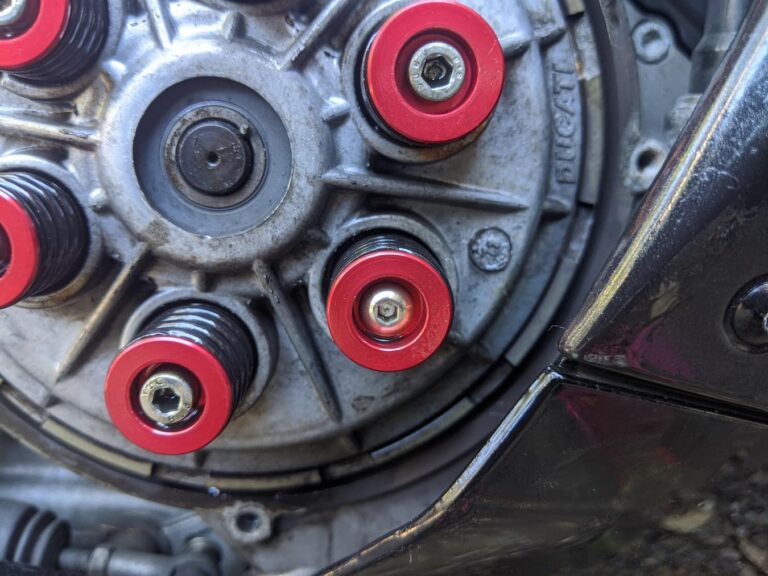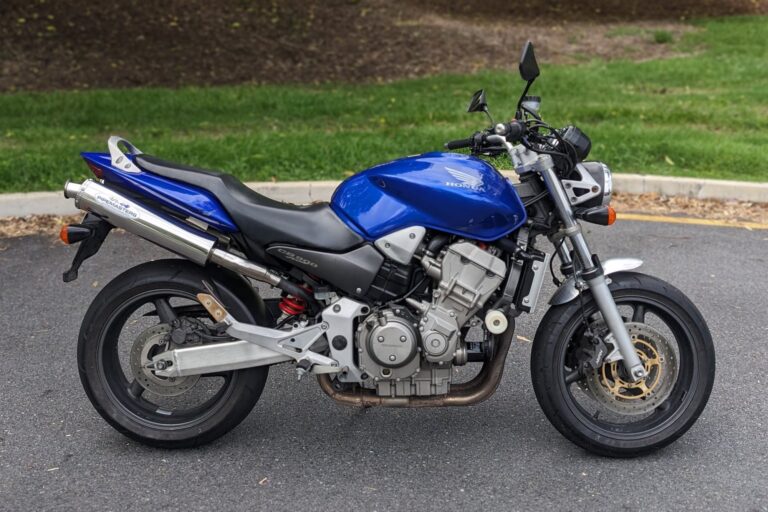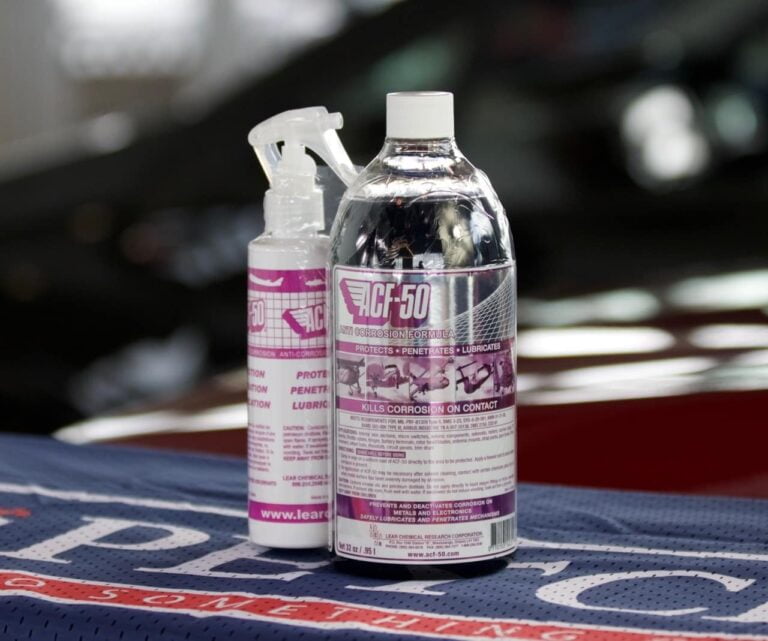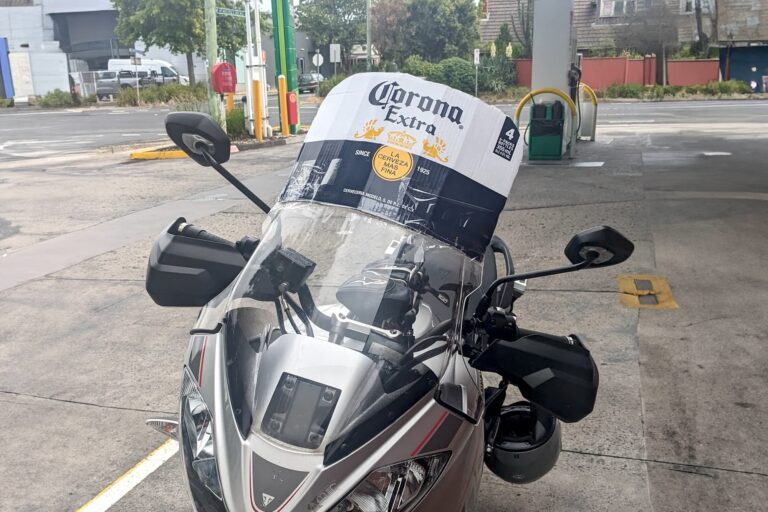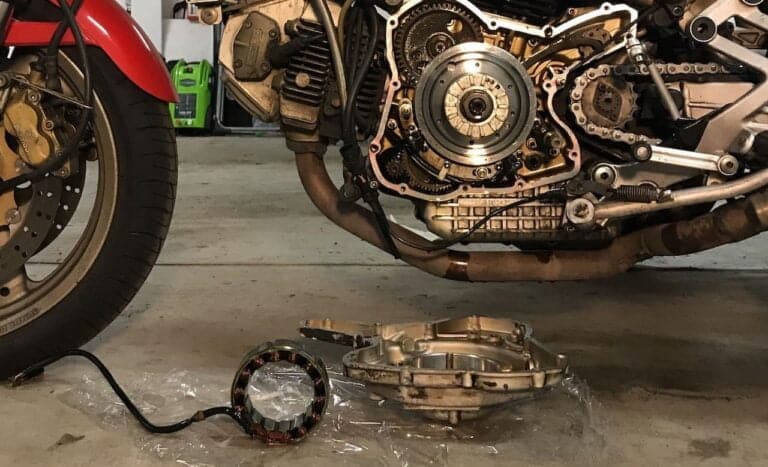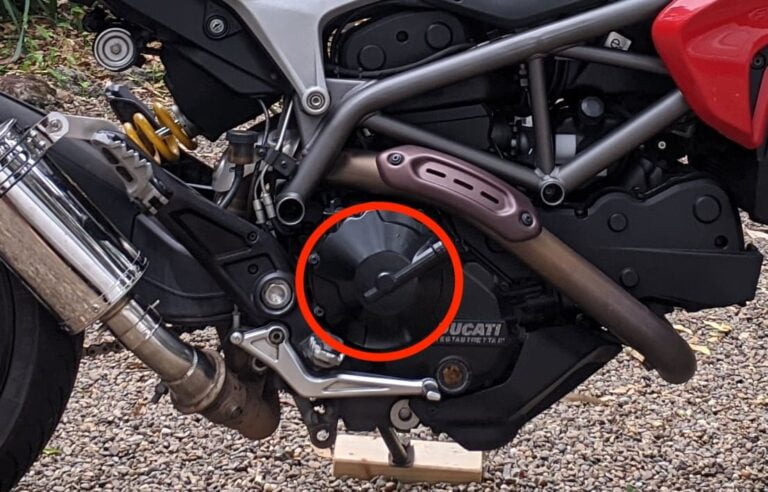When buying a used motorcycle, one of the hardest things to figure out is if it has been crashed before, and one important thing to do is to check motorcycle frame alignment before dropping coin.
It’s really important to know if a motorcycle has been crached because a crash can make a motorcycle harder to drive, and in some cases irreparable.
An unscrupulous (or unknowing) seller will on-sell a crashed motorcycle if they didn’t have comprehensive insurance and so couldn’t total it.
If you suspect a motorcycle has been crashed, there are a few telltale signs… but one of the best ways to be sure it’s not permanently damaged is to check the frame alignment.
OK, this is a slightly obsessive procedure. But if you’re dropping coin on something, you’re within your rights to pull out a piece of string — because that’s all you need to check a motorcycle’s frame alignment — a piece of string! (Mind you, it’s even cooler to do it with a big straight edge.)
A word of warning — just because the frame is aligned doesn’t mean it hasn’t been crashed! The frame might have been weakened, or it might have been damaged in a way that doesn’t affect the alignment (like, a bit broken off).
But the best part is: Checking frame alignment will indicate that you’re a professional. It gives credibility to every other thing you say, whether you find something basic (leaking oil, cosmetic issues, brake pads), intermediate (old fork oil, worn sprockets) or advanced (no valve service history).
Simply doing the test will help you lower the price of the motorcycle.
Are you obsessed with motorcycles?
Well, I am. That’s why I created this site — as an outlet. I love learning and sharing what others might find useful. If you like what you read here, and you’re a fraction as obsessed as I am, you might like to know when I’ve published more. (Check the latest for an idea of what you’ll see.)
When you need to check motorcycle frame alignment
There are a few situations in which checking frame alighment is a good idea.
Firstly, if you think a motorcycle has been damaged, then check frame alignment.
An unscrupulous seller might say in their ad:
- “Lowsided but no frame damage” — says who? You?
- “Some light scuff marks from driveway drop” — how fast were you going on your “driveway”?
- “New fairings” — fine, but is the frame OK?
You might also find some evidence of a crash — like scuff marks on the engine covers, forks, or some other protruding part — and the owner might try to say “eh, it’s no big deal, the bike is fine”.
If the seller tries to pass off a little damage as no big deal, then it’s good to be on the safe side. (On the other hand, if I don’t trust a seller, then I usually walk away pretty quickly.)
In all of these circumstances, the frame might be bent/misaligned. This means the motorcycle will track weird, feel weird, and basically be unsellable.
Note — you can’t immediately detect frame damage on a test ride unless you’re a very experienced rider. It might be minor. My old mechanic could do it, as could a guy I knew who had bought and sold motorcycles for years. Actually, a little tolerance (a few mm) is allowed. But the best way to check, and the best way to negotiate down price, is to do the test.
Secondly, if you have been told that a motorcycle has been crashed, then you also need to check frame alignment.
This is really important to do on any motorbike that has actually been crashed — e.g. a salvage title in the US, or something that has been on the WOVR (Written Off Vehicle Record) in Australia.
If the owner says “it has been crashed, but it’s ok” — your cue to pull out the straight edge or the string.
Even if a motorcycle has been “written off”, though, it doesn’t mean it’s unrideable unless the frame has been bent. If the motorcycle has been professionally inspected, that’s fine. But if not, then you need to check alignment.
How to check motorcycle frame alignment in a nutshell
The general steps of testing motorcycle alignment are:
- Make sure the wheels are both pointing “forwards”
- Hold something straight against the rear wheel and front wheel, and make sure that they run perfectly parallel, with the same gaps on either side (the front wheel is thinner*)
* In the rare case that your rear wheel is thinner than your front wheel, then you do the same procedure, but tie the string to the front wheel.
How to check motorcycle frame alignment – two ways
- Pro: Use a builder’s straight edge. They’re not expensive. They’re just a piece of very straight steel!
- Cool: Use a laser pointer. (A bit harder to do, actually, so I won’t go over it)
- Easy: Use string. Brightly coloured, slightly thicker string. Get a spool, because you need about 5m of it… that kit you stole from a hotel isn’t long enough.
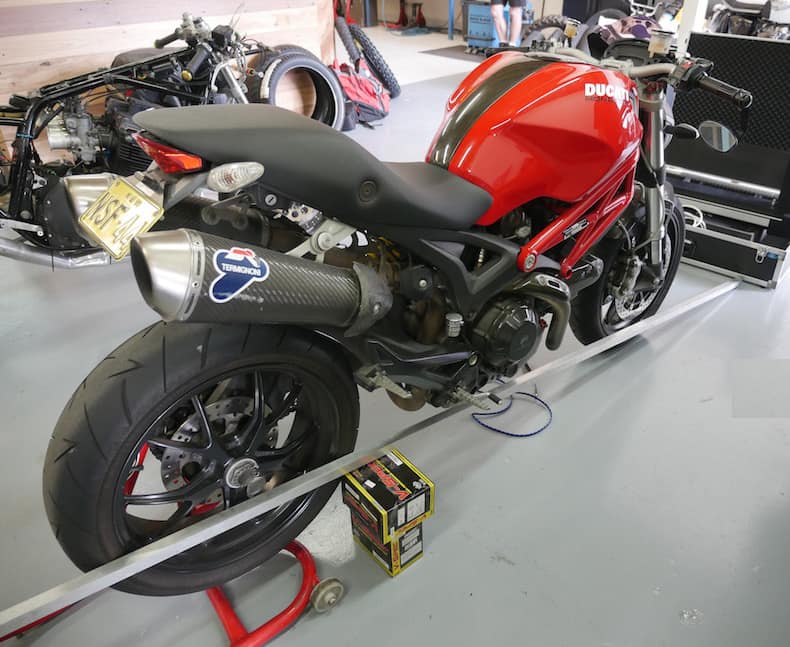
Checking frame alignment with a straight edge
The straight edge is the quickest way to do it. If you can find a hardware store that sells them (or maybe you just want to buy one on Amazon), then pick one up. It’s even easier if you have two straight edges, so you can eyeball the difference directly.
How long a straight edge should you buy? At least 60 inches. 72 inches is a safe bet to make your work more comfortable. Both these lengths are common on Amazon: 60-inch straight edge and 72-inch straight edge.
The procedure to check motorcycle frame alignment with a straight edge is very simple.
- Align the straight edge with the rear wheel (touching the sides of the tyre), protruding to the front of the bike
- Straighten the front wheel so it’s parallel to the straight-edge
- Measure the gaps between the front wheel and the straight edge
- Do the same on the other side.
If the gap is the same (or just a couple of mm different) then you’re golden! Otherwise, the seller has more questions to answer.
Checking frame alignment with a string
If checking with a steel straight edge is inconvenient, then using string to check motorcycle frame alignment is another way. It’s slightly more error prone, and takes a bit longer, but it’s not inconvenient.
Get an eight-foot or longer length of brightly coloured string. You’re going to wrap it around the wheel and the frame of the motorcycle to see if gaps are the same on both sides of the motorcycle.
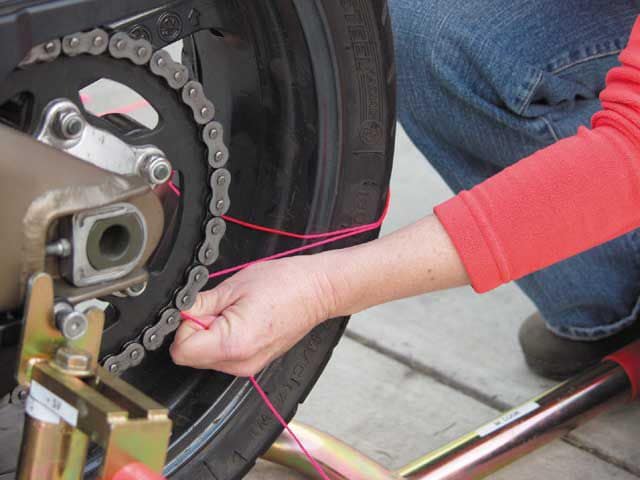
Step 1: Wrap the string’s midpoint around the rear wheel.
Find the midpoint of the string and pass it through the rear wheel. Wrap the string back across the back edge of the tire.
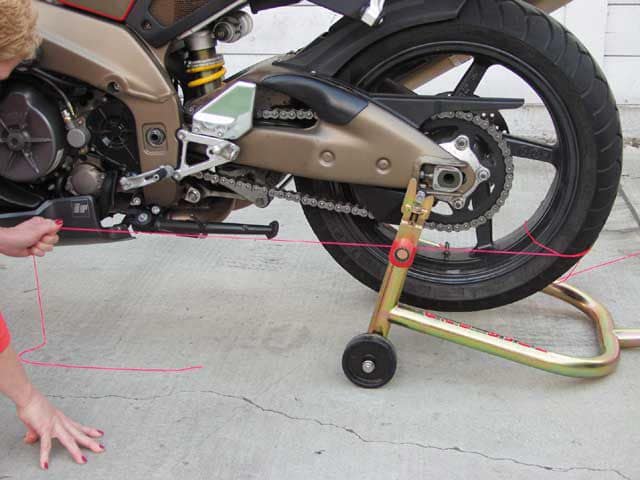
Note: Tie the string low
Make sure the string is tied low so that the string won’t hit the belly pan or stands.
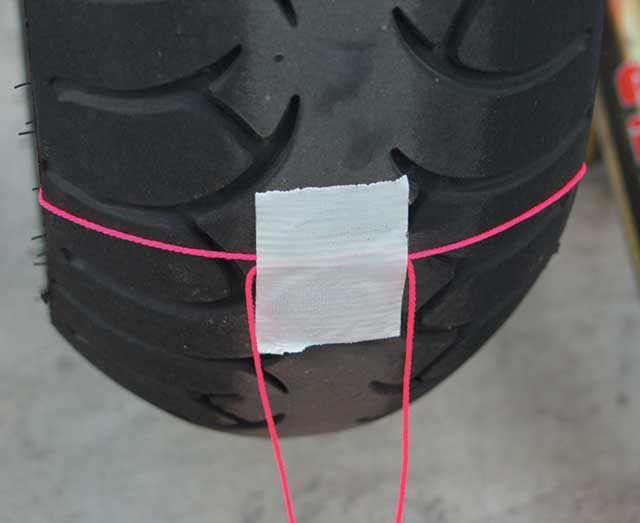
Note: Tape onto tyre (optional)
You can tape the string onto the tyre if you want to hold it in place.
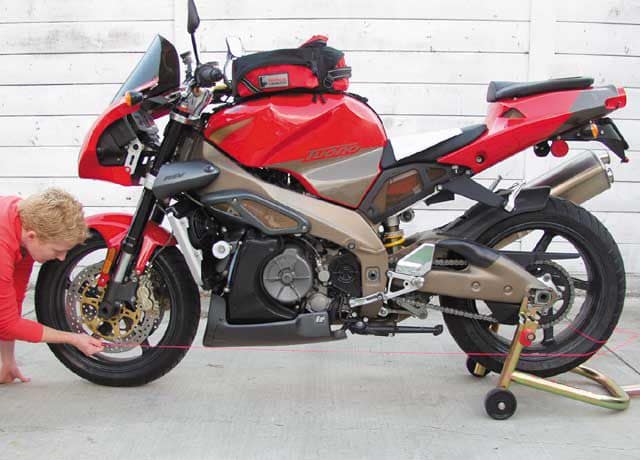
Step 2: Pull the string forward and taut.
Pull the string forward toward the front wheel. Adjust the front wheel so it’s pointing approximately straight ahead – doesn’t have to be exact yet. Make sure you have line of sight to the back wheel. Pull the string taut.
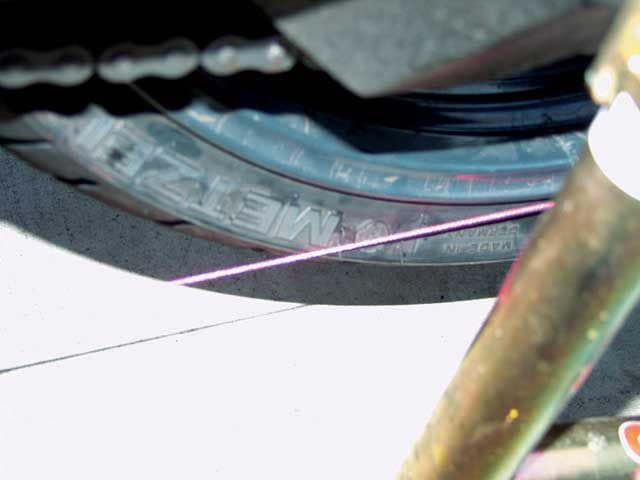
Bring the strings parallel
Take one string, holding it taut, and out from the motorcycle. Pull it in towards the front, and stop bringing it closer when the string touches the front of the rear tyre. Now the string is parallel to the rear tyre.
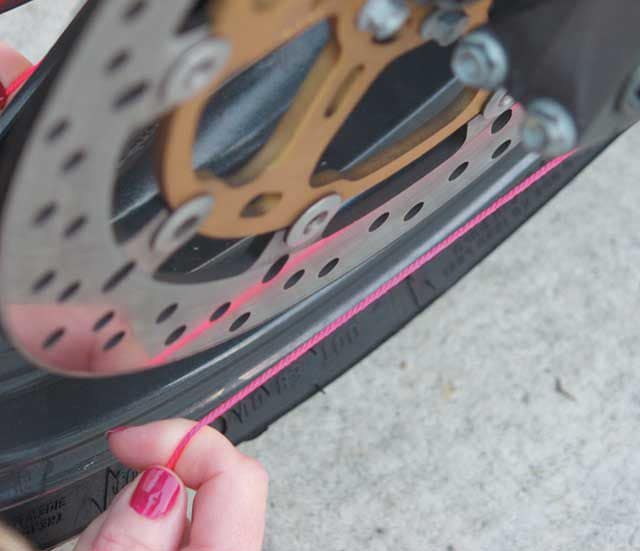
Get the front wheel pointing forwards
Holding the string forward, get the front wheel pointing properly forwards – a helper can nudge the wheel while you hold the string straight.
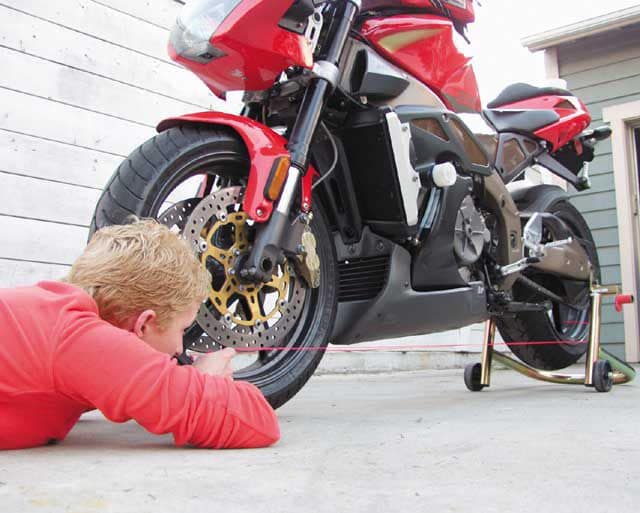
Step 3: Measure!
Compare the distance of the string from one side of the wheel to the other. Properly aligned, the string will be a) parallel to the front wheel, and b) the same distance from both sides.

Eyeball or measure
If the string is closer to the right side of the front tire — as you are viewing it, looking back — then the rear wheel is cocked leading-edge right. Obviously, if the string is closer to the left side (looking back), the rear tire is leading-edge left.
You want two things to be true for an aligned motorcycle:
- The strings should both be parallel to the front wheel, and
- The strings should be the same distance from the wheel at the front and back
If one (or both) of these is not true, you have an alignment problem!
The cause of frame alignment could be benign (someone threw the alignment off when tightening or changing the chain), or severe (crashed). It’s up to you to judge.
But if you know the motorcycle has been crashed, and the wheels are misaligned, then walk away.
A bent frame is expensive and usually impractical to replace unless it’s a special collector’s edition and your pockets are bottomless!

